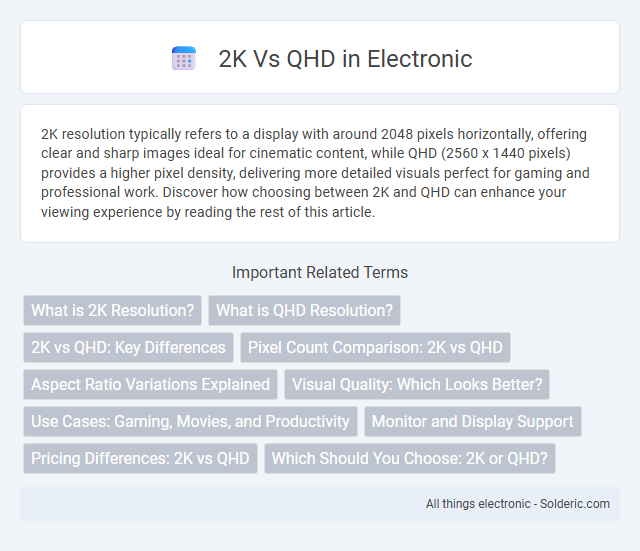2K resolution typically refers to a display with around 2048 pixels horizontally, offering clear and sharp images ideal for cinematic content, while QHD (2560 x 1440 pixels) provides a higher pixel density, delivering more detailed visuals perfect for gaming and professional work. Discover how choosing between 2K and QHD can enhance your viewing experience by reading the rest of this article.
Comparison Table
| Feature | 2K Resolution | QHD Resolution |
|---|---|---|
| Pixel Dimensions | 2048 x 1080 pixels | 2560 x 1440 pixels |
| Aspect Ratio | 17:9 | 16:9 |
| Pixel Count | Approx. 2.2 million pixels | Approx. 3.7 million pixels |
| Image Sharpness | Good for cinema and basic displays | Sharper, ideal for gaming and professional use |
| Common Use Cases | Cinema projection, some monitors | High-end monitors, gaming, graphic design |
| Data Bandwidth Requirement | Lower bandwidth due to fewer pixels | Higher bandwidth needed for increased detail |
| Compatibility | Supported by most media players | Standard for high-res displays, requires compatible GPU |
What is 2K Resolution?
2K resolution refers to a display resolution with approximately 2,000 pixels across the horizontal axis, commonly defined as 2048 x 1080 pixels in digital cinema standards. It offers a higher pixel count than Full HD (1920 x 1080), providing sharper and more detailed images for applications like movies and video editing. While 2K and QHD (2560 x 1440 pixels) both enhance visual clarity over standard HD, QHD delivers increased resolution suitable for gaming and professional use due to its greater pixel density.
What is QHD Resolution?
QHD resolution, also known as Quad HD, measures 2560 x 1440 pixels, offering four times the detail of standard 720p HD. It provides sharper images and smoother visuals compared to 2K resolution, which typically refers to 2048 x 1080 pixels in cinema standards. QHD is widely used in high-end smartphones, monitors, and laptops for enhanced clarity and immersive viewing experiences.
2K vs QHD: Key Differences
2K resolution typically refers to a display resolution of 2048x1080 pixels, primarily used in digital cinema, while QHD (Quad High Definition) offers a higher resolution of 2560x1440 pixels, common in high-end monitors and smartphones. The increased pixel count in QHD provides sharper images, enhanced detail, and better overall visual clarity compared to 2K. For gaming and professional use, QHD delivers superior screen real estate and finer image quality, making it more suitable for tasks requiring precision and immersive visuals.
Pixel Count Comparison: 2K vs QHD
2K resolution typically refers to a display with approximately 2048 x 1080 pixels, totaling around 2.2 million pixels, while QHD (Quad High Definition) offers a resolution of 2560 x 1440 pixels, amounting to about 3.7 million pixels. This difference means QHD provides roughly 78% more pixels than 2K, resulting in sharper images and finer detail on the screen. For your viewing experience, choosing QHD ensures higher pixel density and improved clarity, especially on larger displays.
Aspect Ratio Variations Explained
2K resolution typically refers to 2560x1440 pixels and aligns with a 16:9 aspect ratio, offering widescreen visuals ideal for gaming and multimedia. QHD, standing for Quad High Definition, also uses 2560x1440 resolution but emphasizes image clarity and sharpness, making it a standard for high-resolution displays. Variations in aspect ratios arise when similar resolutions are applied to screens with different widths and heights, such as 21:9 ultrawide formats versus the common 16:9, affecting the field of view and viewing experience in 2K and QHD monitors.
Visual Quality: Which Looks Better?
QHD (2560x1440) offers a higher pixel density than 2K (often 2048x1080), resulting in sharper and more detailed images, especially on larger screens. With approximately 3.7 million pixels compared to 2.2 million pixels in 2K, QHD provides richer textures and clearer visuals, enhancing your viewing experience for gaming, media, and professional work. Choosing QHD ensures superior visual quality and crispness that is noticeably better than standard 2K resolution.
Use Cases: Gaming, Movies, and Productivity
2K resolution (2560x1440) offers a sharper image than Full HD for gaming, providing improved detail and smoother textures without demanding extreme GPU power, making it ideal for competitive and casual gamers. QHD, often synonymous with 2K, enhances movie viewing by delivering vibrant colors and crisp visuals on larger screens, improving overall immersion. For productivity, QHD supports extensive screen real estate, allowing multiple windows and detailed workspaces, benefiting creatives, developers, and multitaskers who require clarity and precision.
Monitor and Display Support
2K resolution typically refers to 2560x1440 pixels, commonly supported by QHD monitors, offering sharper image quality and more screen real estate compared to Full HD. QHD, also known as 1440p, is widely supported by modern displays, providing an ideal balance between standard 1080p and 4K resolutions for gaming, professional work, and multimedia. Most mid to high-end monitors feature QHD panels with support for higher refresh rates and color accuracies, enhancing visual detail and performance over traditional 2K setups.
Pricing Differences: 2K vs QHD
2K resolution typically refers to 2048 x 1080 pixels, while QHD stands for Quad HD with 2560 x 1440 pixels, offering higher pixel density and sharper images. Pricing differences between 2K and QHD monitors or displays primarily reflect the increased manufacturing cost and demand for better visual quality in QHD screens, often making QHD models 20-30% more expensive than 2K counterparts. When choosing your display, consider that investing in QHD provides enhanced clarity and detail suitable for gaming, professional work, and multimedia use, justifying the price premium over 2K options.
Which Should You Choose: 2K or QHD?
Choosing between 2K and QHD depends on your display resolution needs and device compatibility. QHD, with a resolution of 2560x1440 pixels, offers sharper image quality and more screen real estate compared to the slightly lower resolution of 2K, which is approximately 2048x1080 pixels. Your decision should prioritize QHD if you seek enhanced clarity for gaming, professional design, or media consumption on larger monitors.
2K vs QHD Infographic

 solderic.com
solderic.com